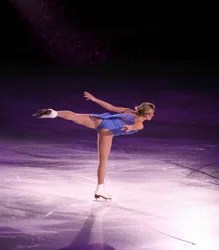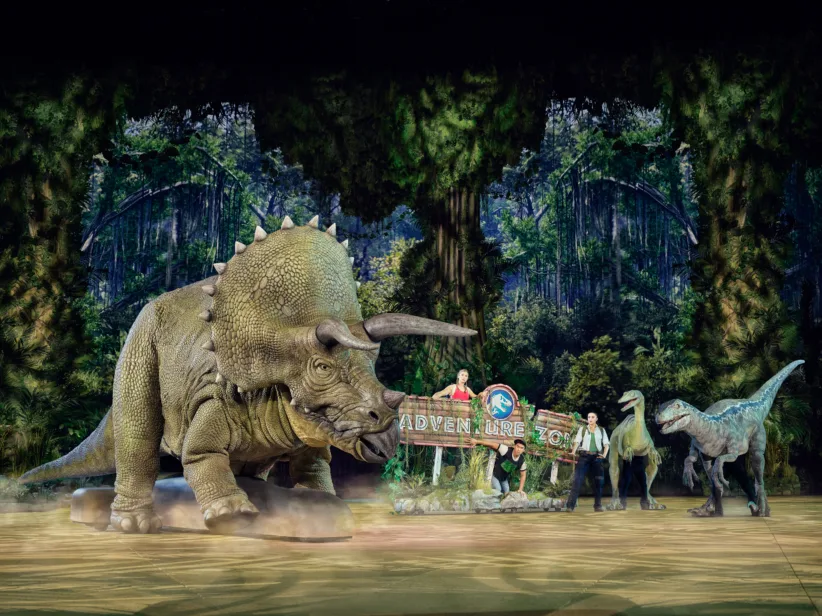 Figure skating is recognized for its elegance and grace…except when it comes to terminology. Camel spin…what? Triple sal…who? Lutz…why? Luckily, when spelled out and explained, it is possible to comprehend the sport while admiring its beauty visually. As one of the most popular sports in the 2010 winter Olympics in Vancouver, figure skating will be watched by thousands of families on television. Understanding the logistics of the sport will enhance the experience of watching the competition with your family and help you explain it to your kids. So here you go…
Figure skating is recognized for its elegance and grace…except when it comes to terminology. Camel spin…what? Triple sal…who? Lutz…why? Luckily, when spelled out and explained, it is possible to comprehend the sport while admiring its beauty visually. As one of the most popular sports in the 2010 winter Olympics in Vancouver, figure skating will be watched by thousands of families on television. Understanding the logistics of the sport will enhance the experience of watching the competition with your family and help you explain it to your kids. So here you go…
Founded in Vienna, Austria in the 1860s, ice-skating competition was introduced to the Olympics in the 1908 Summer Games. Currently, a panel of nine International Skating Union championship judges use computers to evaluate each skater’s technical and presentation abilities. Seven of the nine scores are then chosen at random to formulate the individual’s average, according to www.vancouver2010.com. The skater with the highest technical and program scores combined is the winner. “Because most moves require split second coordination, in a figure skating competition, a skater can take nothing for granted,” says Lisa Fedick, the head coach of Figure Skating at Sacred Heart University and general manager of Wonderland of Ice in Bridgeport, CT.
Within the sport there are several different programs that the judges score. In singles skating, there is a short program comprised of a maximum two minutes and 50 seconds, and a longer free skating program of four minutes for women and four minutes and 30 seconds for men, according to www.vancouver2010.com. The short program contains required jumps and combinations while the free skate is used to demonstrate the skater’s personal creativity and talent. Pairs skating follows the same format but includes both one male and one female and incorporates lifts, spins and spirals linked harmoniously through movements in the routines.
The Short Program
There are several required elements in the women’s short program with similar provisions for men:
Double axel: This element takes off from the outside of one skate, completes two and a half rotations and lands on the edge of the opposite foot. “The hardest jump in figure skating is the axel. When people talk about jumps like the ‘triple salchow,’ it means three rotations in the air but with the triple axel it is three and a half rotations in air,” says Elise Gallagher, director of figure skating at City Pavilion Ice in Queens.
Triple jump: This includes three revolutions.
Jump combination: This consists of a double leading to a triple, or two triples in a row.
Flying spin: This requirement involves a leap into the air, and a layback spin where the skater arches the back and faces the ceiling.
In addition, each program must have a spin combination with one change of foot, a spiral sequence where the skater glides across the ice with one leg extended into the air, and a step sequence that can be done in a line, circle or serpentine style. The men have the same requirements with the addition of a camel spin where the free leg is extended parallel to the ice and the upper body inclined forward with extended arms, and a second step sequence, according to www.vancouver2010.com.
For pairs, there are several lift requirements including a double or triple twist lift where the male raises the female partner above his head and tosses her in the air for several rotations. Skaters are obliged to include a throw jump where the female is thrown into the air and lands on the ice, as well as a side-by-side double or triple jump and spin combination. There must be a death spiral that involves the partners holding hands while the male is spinning in pivot position and the female is spinning in horizontal position with her body parallel to the ice. A pairs spin combination and spin or step sequence is also required.
“Since the programs can be two to four minutes in length, depending on the level, at the end of the program, your legs are tired and your breathing is labored,” says Autumn Scibelli who has earned several gold level tests in several skating categories. “Also, at intermediate to higher levels, skaters are required to do a ‘footwork’ sequence, which is a combination of intricate moves that can be difficult to do without tripping up.”
The Free Skate Program
In the free skate, the skaters are given more leeway in order to challenge themselves and earn higher scores.
Lutz jump: Named after Alois Lutz, an Austrian figure skater who first performed the jump in 1913, this jump involves the skater gliding backwards on a wide curve and using a toe pick to launch off the ground and land on the opposite foot.
Salchow: Named after Ulrich Salchow who won the first Olympic gold medal for men’s figure skating in 1908 and also claimed 10 world championship titles. In this jump, the skater departs the ice on the back inside edge and lands on the back outside edge of the opposite foot. When performing edge jumps like the axel and salchow, the skater launches into the air without placing the free foot on the ice for assistance.
Perfecting these jumps from takeoff to landing is what enables the skaters to earn technical points, although it’s a difficult task. Falling is a fundamental part of the sport and by picking themselves up without fear, skaters learn and progress to future success. “In most cases the fall occurs on the exit portion of the jump rather than the takeoff and several issues can cause a fall at that point. Timing, weakness in basic jumping skills, improper takeoff and improper jump placement on the circle are just a few of the causes,” says Kenny Moire, director of figure skating at Chelsea Piers. “Skaters have learned to fall correctly and falling on jumps is part of the sport. The rewards outweigh the bumps and bruises.”
Jaques Gilson, who was an active member of The Skating Club of New York, and now skates and coaches at his own school in Baltimore, adds, “What you have to do and what I tell all of my students, is that good or bad, land or fall…you cannot go back and repeat the element that was just completed. No matter what happens you have to put it out of your head and concentrate on what you’re doing at the time.”
The Details:
The Vancouver 2010 Winter Olympics Opening Ceremony takes place on February 12th and the figure skating competition kicks off with the Pairs Short Program on February 14th at 4:30pm and ends on February 27th at 4:30pm with the Exhibition Gala. There will be 20 pairs teams, and 30 men and 30 women competing. For more information, visit www.vancouver2010.com.
Enjoy viewing the magnificence of this Olympic sport while sounding like a professional with your family and friends!
Don’t Miss!
Intense rivalry, broken records, and history in the making…here are the must-sees!
2/12, 9pm – The Opening Ceremony: Held at Vancouver’s BC Place.
2/13, 2:45pm – 2/27, 4:45pm – Alpine Skiing: American Lindsay Vonn, overall and downhill champion at the World Cup for the second consecutive year, contends for a medal in five Olympic events. She must fend off best friend, Maria Riesch of Germany, who won the slalom world title and finished second in the overall World Cup standings to Vonn.
For the men, Aksel Lund Svindal of Norway is the clear favorite, having claimed five world medals.
2/13, 8pm – 2/26, 10:52pm – Short Track: American Apolo Ohno, five-time Olympic medalist, returns having also claimed the 2007 Dancing With the Stars champion title!
For the women, China’s Wang Meng could sweep golds after winning individual golds in both the 500m and 1000m events at the 2009 World Championships in Vienna.
2/14, 12pm – 2/25, 4pm – Nordic Combined: Americans Bill Demong and Todd Lodwick, both reigning world champions, look to win the U.S.’s first Olympic Nordic combined medal. Austrian competitor Felix Gottwald is the most accomplished contender in Olympic history, medaling in six straight Olympic starts.
2/15, 3pm – 2/27, 5:17pm – Speed Skating: American Shani Davis, the defending Olympic champion in the 1000m, is the favorite in the 1000m and the 1500m. He has won four out of four 1000m races and four out of five 1500m races in the World Cup circuit this season.
2/14, 3pm (first meeting) – Women’s Hockey: The U.S. and Canada have played in the final in all but one international tournament since women’s world championships began in 1990. The Americans are two-time defending world champions and the Canadians are two-time defending Olympic champions.
2/14, 7:30pm -2/27, 7:30pm – Figure Skating: Yevgeny Plushenko of Russia looks to make history as the first man to win two straight golds in more than half a century, the second man to win more than two Olympic medals, and the sixth straight Olympic gold medalist from Russia/the former Soviet Union.
For the women, don’t miss teenage rivals Kim Yu-Na of South Korea and Mao Asada of Japan. Although the U.S. only qualified two skaters, look for Rachael Flatt who finished fifth at 2009.
2/28, 9pm – The Closing Ceremony: Held at BC Place.
The 2010 Winter Olympics will be broadcast on NBC. For more information, visit www.nbcolympics.com.





















